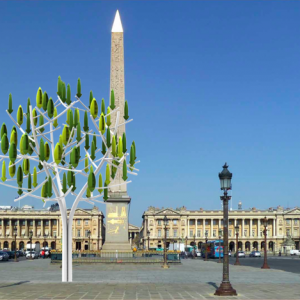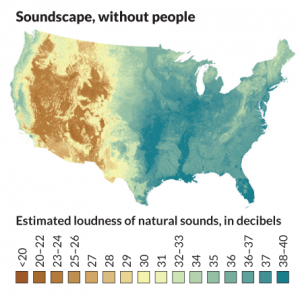Posted on March 29th, 2015 by Mary Lord

If you’re experiencing the winter blues, take a few minutes to watch this GoPro-connected Combat Creature play with a litter of kittens and one feisty cat. Smiles guaranteed!
Filed under: e-Videos | Comments Off on Kittens vs. Combat Robot
Posted on March 29th, 2015 by Mary Lord

Where do inventors get their great ideas?
For French entrepreneur Jérôme Michaud-Larivière, inspiration for his tree-like wind turbine struck while he was sitting on a park bench, watching leaves flutter.
 His first Wind Tree goes up in Paris’s Place de la Concorde later this year. (Photo, left) Its steel trunk stands 36 feet tall and has 72 artificial leaf-like micro-turbines that spin vertically on an axis. Unlike industrial-sized turbines, it’s silent – all of its cables and generators are buried deep within its leaves and branches. And it can create power even from light breezes, allowing it to provide electricity for more than 280 days a year.
His first Wind Tree goes up in Paris’s Place de la Concorde later this year. (Photo, left) Its steel trunk stands 36 feet tall and has 72 artificial leaf-like micro-turbines that spin vertically on an axis. Unlike industrial-sized turbines, it’s silent – all of its cables and generators are buried deep within its leaves and branches. And it can create power even from light breezes, allowing it to provide electricity for more than 280 days a year.
If the prototype works as well as Michaud-Larivière hopes, it could blossom into a forest of turbines across Paris and beyond. Also in the works at his New Wind company: “foliage” that can be installed on rooftops or along roads, and a scaled down “wind bush.”
Photo courtesy of Wind Tree
Filed under: e-News, Environmental | Comments Off on Leaf Blower
Posted on February 26th, 2015 by Mary Lord

If a tree falls in the forest… the National Park Service may have recorded it, along with howling wolves, thunder crackling, and other natural sounds. That includes man-made noise like chainsaws and cannon fire at Ft. McHenry!
For the past decade, hundreds of microphones have been eavesdropping in parks across the country, capturing everything from avalanches and bugs to frogs and whales. This Natural Sounds Program was designed to protect America’s acoustic resources. You can listen to an online sound gallery or view several videos.
Even in the wilderness, peace and quiet can be hard to find. Human noise pollution – the roar of traffic, for instance, like this cool time-lapse map showing motorcycle noise in Glacier National Park – can disrupt the environment, a scientist behind the bio-acoustical project told National Public Radio. Animals may not be able to hear their prey and catch dinner. Birds might fly off course.
 The National Park Service just released a sound map (image, right) showing decibel levels nationwide. The East Coast, not surprisingly, is noisier than the West Coast.
The National Park Service just released a sound map (image, right) showing decibel levels nationwide. The East Coast, not surprisingly, is noisier than the West Coast.
The good news is, people can turn down the volume and dramatically improve the environment. Even little things, such as speaking softly on a mountain trail or leaving your cellphone at home, can have a big impact.
So what does the fox say?
There’s no call of the wild in the National Park Service’s Soundscape Gallery. But Ylvis has an answer in this viral hit tune:

Filed under: e-News, e-Videos, Environmental, Explore Engineering | Comments Off on What Does the Fox Say?
Posted on February 25th, 2015 by Mary Lord
Remember how bluebirds helped Snow White clean an abandoned cottage in the Disney classic?
Meet Spider Drone, a quadcopter that weaves structures out of steel cables and can operate at heights unreachable by ordinary building equipment.
Developed by engineers and architects at Switzerland’s Federal Institute of Technology, the quadcopters spool out strong plastic cable as they fly. A computer equipped with a camera can direct them to fly through certain points and exact times to loop cables around each other or secure them to poles.
The designers envision that one day, fleets of spider drones could tie complicated knots and build bridges between skyscrapers.
Meanwhile, researchers at the Massachusetts Institute of Technology’s Media Lab have created a robotic arm that can spin a web.
Filed under: Civil, e-News, e-Videos, Explore Engineering | Comments Off on Spider ‘Bot Weaves Towers
Posted on February 22nd, 2015 by Mary Lord

One teen created a battery-free flashlight powered by heat from the user’s palm on the handle.
Another build a flying robot inspired by fruit flies.
The free, online competition is open to students worldwide who are between 13 and 18 years of age.
Prizes include a $50,000 scholarship, trips to the Galapagos or to LEGO headquarters in Denmark, and first-hand look at Virgin Galactic’s latest spacecraft.
Projects can come from across all scientific fields, including biology, computer science, and anthropology, and must be
submitted online by
MAY 19, 2015.
Click
HERE to read the 2015 rules.
Filed under: Contests | Comments Off on Google Science Fair 2015















